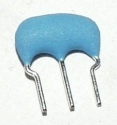ico
Member Since: June 17, 2010
Country: China
-
Most established PCB fabs charge the engineering fee of a new board with about US$50 for this size of 2 layer board, but the volume price of production board is another story.
If you want cheap price of this kind of initial board setup engineering fee, a professional prototype PCB fab or some small unestablished companies have much lower price, as minimal as about US$20, but mostly of worse quality, and you need luck to find a good one with low price. -
The 16MHz external crystal can at best work for a baud rate up to 19200, it does not work with any higher baud rate for the accuracy is too low after the prescaler division.
To work for higher baud rate such as 115200, a precise UART friendly external crystal frequency is needed, such as 11.0592MHz (115200 * 96) or 7.3728MHz (115200 * 64).
I've not tried these UART friendly crystal oscillators on AVR, because I recently have done a project using ST's STM32F101RB, an ARM Cortex M3 MCU, it's just about US$2, and with more features than similarly priced AVR or other architectures (PIC, C51 etc), and the performance is just not comparable.
ARM Cortex is the king, I'll abandon all other CPU architectures from now on, except in some rare cases where the extreme low power requirement is a must. -
It's always good to have all the supported oscillators in hand, when the fuse is written but the ATMega does not respond again, just try each oscillator in order, and it'll be restored, at least my ATMega48PA is restored this way.
My CPU clock can be at most set to 16MHz with 1:1 prescaler to make the avrdude still work well without any error, if I use a 20MHz crystal, avrdude will report a wrong Device signature of 0x000102 mostly, it'll still try to write flash/fuse etc, and succeed to update the flash/fuse sometimes, but always verify wrong.
I use a BSD style parallel cable of about 1.5 meter, I guess the cable is too long to have a reliable SPI signals on 20MHz clkCPU above? -
The LM7805 ouput is 4.3V when using a 5V power supply, but 5.01V when using a 9V or 18V power supply.
Checked the datasheet of LM7805, which said it should works well on input Vo = 5V to 18V and 24V, not sure why it ouput 4.3V when the input is 5V only.
No public wish lists :(



